Abstract
The most significant and rapidly expanding fintech services in Nepal are provided by several fintech firms. Customer satisfaction must be compared side by side even if every organization has made an effort to expand the usage of services. Many studies have concentrated on evaluating the impact of various factors on customer satisfaction, but significantly fewer studies have been conducted to explore the factors and focus of machine learning. Based on the planned behavioural theory (TPB), the study is concentrated on exploring and evaluating customer satisfaction on a different stimulus offered by F1 Soft (a fintech firm in nepal), customers’ loyalty and the compatibility they gain through the company’s services. By exploring various factors affecting customer satisfaction by using principal component analysis (PCA) and explainable AI (XAI), the study explored the eight factors (customer service, compatibility, ease of use, assurance, loyalty intention, technology perception, speed and firm’s innovativeness) which affect customer satisfaction individually. Furthermore, by using support vector machine (SVM) and logistic regression (LR), the major contributing factors are explained with local interpretable model-agnostic explanation (LIME) and Shapley additive explanations (SHAP). SVM holds the training accuracy of 89.13% whereas LR achieves 87.88%, and both algorithms show that compatibilty issues consider the major contributing factor for customer satisfaction. Contributing toward different dimensions, determinants, and the results of customer satisfaction in fintech, the study suggests how fintech companies must integrate factors affecting customer satisfaction in their system for further process development.
1. Introduction
Technological innovation and digitization are facing challenges in the financial sector of Nepal, but they also enhance customer satisfaction. The term customer satisfaction does not have an exact definition; rather, it is multifaceted and could be interpreted and analyzed from different perspectives. However, fintech has been in the limelight, and it represents the application of new information technology in the financial arena. Fintech integrates the two fields of finance and technology, which becomes financial technology, or fintech [1]. Fintech firms are under growing pressure to deliver superior customer service in order to differentiate themselves from other, similar organizations and increase their clientele. In order to cater to the demands of each unique consumer, fintech businesses are creating individualized services carefully crafting customised marketing. These businesses are utilizing data to support their expansion. Businesses in Nepal at the moment employ stimulation strategies like cash back, incentive points, etc. This conceptualizes the innovative financial services offered by the financial institutions, backed up by development in information and communication technology (ICT) [2]. Moreover, fintech encompasses innovative financial institutions which offer financial services based on new technological advancement such as the Internet of things (IoT), artificial intelligence (AI), blockchain, near-field communication (NFC), digital wallets, and so on [3]. Advancement in ICT accelerates the financial services offered by the financial institution facilitating data collection, analysis, interpretation, and quick delivery of services [4]. Based on ICT, most of the financial services will be progressively executed electronically, without human mediation, with an ultimate goal of enhancing customer satisfaction [5].
Additionally, a number of studies have already covered the behavioral elements that affect customers’ happiness with the service industry. For online food-delivery systems (OFDS), Yeo et al. [6] analysed hedonic motivation, prior online purchases, time-saving orientation, and price-saving orientation as the influencing factors. On the other hand, Lau et al. [7] implemented the theory of planned behavior (TBP) to pinpoint perceived ease of use, time-saving orientation, convenience motive, privacy, and security. In the context of bank consolidation, Farah [8] used a TBP to forecast intentions to buy sustainable homes. The dearth of studies on the application of TPB to solve fintech despite the existence of studies regarding customer loyalty and satisfaction toward OFDS system apps, online retail, and other service industries [6,7,9,10]. The majority of studies evaluated the effects of numerous factors on customer satisfaction implementing TPB. On the contrary, a relatively small number of studies were undertaken to delve into the variables and focused on machine learning, which can stand as a crucial future applications.
To generalize, Equation (1) represents behavioral intention in the theory of planned behavior [11],
where represents behavioral intention, A represents attitude toward behavior, represents subjective norm, represents perceived behavioral control, A is proportional to , is proportional to , is proportional to , b represents strength of each belief concerning an outcome, e represents the evaluation of the outcome, n represents the strength of each normative belief, m represents the motivation, c represents the strength of each control belief, and p represents the perceived power of the control factor.
Although AI primarily focuses on different computer visions [12], medical image analysis [13], network optimization [14], intrusion detection [15], image steganography [16], adversarial attacks [17], deep fakes [18], and similar fields, few studies have been found that explore the factors affecting the customer satisfaction in fintech companies and the use of machine learning (ML) to define such factors in Nepal. The explainability of ML techniques has emerged as a critical concern, particularly in the most regulated industries, including health and finance [19]. The study attempts to resolve such research gap with reference to the Nepalese fintech firm F1 Soft.
From a customer perspective, the recent expansion of the mobile payment sector led by innovative financial technology payment services such as Esewa, Khalti, IME Pay, Prabhu Pay, iCash, dPaisa, FonePay, etc. are the most important and fastest-growing fintech services in Nepal. Although every business makes an effort to spread the use of services, customer satisfaction must be measured side by side. Although significant, customer satisfaction with regard to fintech services has not been extensively researched in the Nepalese context.
The objectives of the study are as follows:
- to explore and clarify the major influencing factors of customer satisfaction in fintech industry, by virtue of studying F1 Soft of Nepal; and
- to implement the ML model and interpret the results with LIME and SHAP.
Continuing further, Section 2 details the existing works on customer satisfaction, PCA, and machine learning approaches. Section 3 describes the data collection and proposed methods. Experimental results obtained by using PCA, ML, and XAI are discussed in Section 4. Section 5 provides a discussion, the implications, and the limitations and future research.
2. Related Works
2.1. Customer Satisfaction
Over the years, many studies have been carried out to analyze the impact of various factors on customer satisfaction. Ref. [20] conducted a study on service-quality perception and customer satisfaction in the Nepalese banking sector. They used a questionnaire including 27 questions relating to the five dimensions: reliability, assurance, tangibility, empathy, and responsiveness of service quality and found strong and significant (at the 0.01 level) correlation between service-quality dimensions and customer satisfaction. A similar kind of study was performed by [21], in which the author used reliability, responsiveness, assurance, empathy, and such tangible factors as predictor and customer satisfaction as response and found the customer satisfaction of commercial banks was based on service quality. Ref. [22] went through the study of corporate social responsibility and customer satisfaction in Nepal, incorporating banking, manufacturing, insurance, telecommunication, Internet service provider, and hotel sectors. Their findings suggest that the relationship with the community is the major area of social responsibility and that promotion of corporate image is the main driving force behind the adoption of corporate social responsibility (CSR). Independent variables have positive and significant (p = 0.05) relationship with customer satisfaction. Accessibility, reliability, convenience and security of e-banking services were used as customer satisfaction metrics and it was found that all the regressors were significant (p = 0.01) [23].
Consequently, in a study on recommender system customer satisfaction, authors in [24] found that when using a deep learning-based recommender system, accuracy and diversification had a favorable impact on customer satisfaction. In contrast, when using conventional recommender systems, only accuracy has a beneficial impact on customer satisfaction. In the same vein, writers in [25] conducted a study by using three factors of customer satisfaction and found that, if correctly implemented and presented, hotel green initiatives would please customers. Furthermore, hedonic motivation, followed by pricing, information quality, and promotion, was found to have the greatest impact on customer satisfaction in research on an OFDS done during the COVID-19 pandemic. It is interesting that this study discovered that usability parameters like perceived ease of use and navigational design have no impact on customer loyalty and satisfaction in OFDS under the COVID-19 new normal [26].
2.2. Principal Component Analysis
With a high number of dimensions or features per observation, principal component analysis (PCA) is a common method for analyzing huge datasets and improving data interpretation while retaining most of the information and enabling the presentation of multidimensional data [27]. Principal components are a series of projections of the data that are ordered in variance and mutually uncorrelated. They are created as linear manifolds that roughly have a set of N points [28]. PCA aims to uncover crucial coherence and correlation among the variables by aggregating highly correlated variables and creating new composite measures that represent groups of subvariables [29]. For the purpose of determining the number of factors that should be retained, various extraction methods can be used. Kaiser’s criterion states that only those elements with equal eigenvalues or greater eigenvalues will be maintained in the model. Ref. [30] suggested the scree plot, cumulative percent of extracted variance, and parallel analysis for the purpose of determining factors that should be retained. Othogonal varimax was often used for rotational approach.
Ref. [31] explored the qualities of a good leadership by using PCA and found 13 factors that define a good leader. Similarly, [29] conducted a study entitled “Internal Marketing: An Application of PCA”, the results of which supported the usefulness of the suggested framework, which may be used as a statistical and management tool for staff development and organizational effectiveness. The elements that were taken into consideration were interfunctional coordination, training, information transmission, motivation, understanding, distinction, and strategic reward. Ref. [32] explored the factors affecting customer satisfaction in e-banking, by studying the three major factors of service quality, brand perception, and perceived value.
2.3. Machine Learning
The authors of [33] studied machine learning based on customer metacombination and brand equity analysis for the evaluation of marketing behavior. The study survey covered four main areas: customer satisfaction, a general overview of customer satisfaction, the benefits and drawbacks of marketing strategies through quantitative analysis, and the presentation of reasonable marketing strategy, suggestions, and opinions with regard to improvement. Ref. [34] provides a ML-based matching analysis method, called CAMP, by which not only the semantics and sentiment of customer comments and agent notes can be properly and thoroughly studied, but also the granular and fine-grained characteristics can be discovered. The CAMP method may offer helpful advice for providing follow-up care, and automation can hasten the time for service response, both of which ultimately increase customer happiness and customer loyalty.
3. Data and Methodology
3.1. Data Collection
F1Soft is an ecosystem of digital products and offerings that makes it easier, more inexpensive, and more secure for Nepali consumers to obtain financial services and to participate in the formal digital economy. The company has spent more than 10 years developing innovative digital financial services (DFS) and products, and it is proud to have created Nepal’s first-ever online payment gateway and digital wallet [35].
Data were collected from customers of F1 Soft products Esewa and FonePay (in the month of April 2022). The survey was conducted through a structured online questionnaire by using a five-point Likert scale [36,37] in the bipolar format (1 = strongly disagree to 5 = strongly agree and 1 = very unlikely to 5 = very likely) and dichotomous format (use of mobile payment services of F1 Soft is fully satisfying—Yes = 1 and No = 0) for dependent variable customer satisfaction. As judgmental sampling involves the choice of subjects who are most advantageously placed or in the best position to provide the required information, 1100 emails were sent to the respondents on the basis of judgement sampling because F1 Soft does not provide customer-related data due to legal constraints [32]. Samples were collected only from users of F1 Soft products who were more than 15 years of age [38] by using Google Form. Emails were collected from colleges, business institutions, industries, and the service sector. The sample was initially drawn from colleges located in Kathmandu, affiliated to Tribhuvan University, Nepal (the sampling frame) but supplemented with respondent recommendation and other additions, by using the judgment sampling methodology.
Out of the 1100 emails, 417 responses were received representing the response rate of 37.91%; however, only 403 (n = 403) responses were used for analysis after filtering 14 incomplete responses by using the data screening method. In addition to those 417 responses, 10 users of different ages were monitored while filling up the response. On the basis of those responses, restrictions regarding age and text fields were designed again. On top of that, the overall demographic descriptions are shown in Table 1.

Table 1.
Frequency distribution of demographic variables.
Email and postal data collection method have only a limited reach in the context of Nepal [39], and South Asia. Indirect surveys frequently have low response rates [40]; hence, the aforementioned response rate might be viewed as rather excellent in the context of Nepal.
3.2. Sampling Adequacy Measure
The Kaiser–Meyer–Olkin (KMO) measure of sample adequacy (MSA) and Bartlett test of sphericity (BTS) were undertaken for the data on variables affecting the customer satisfaction of fintech firm to determine whether the data were acceptable for further analysis. The BTS value was determined to be significant at p = 0.000 and the KMO value was 0.882, which is above 0.50 (Table 2). The data’s factorability is supported by the KMO value of 0.882, which is higher than the advised value of 0.6 [41,42,43] and the statistical significance of Bartlett’s test of sphericity [44].

Table 2.
KMO and Bartlett’s test of sphericity.
3.3. Proposed Methodology
The model’s abstract architecture, which includes data preparation, component analysis, several ML models, statistical performance indicators, and frameworks for explanation extraction, is shown in Figure 1.
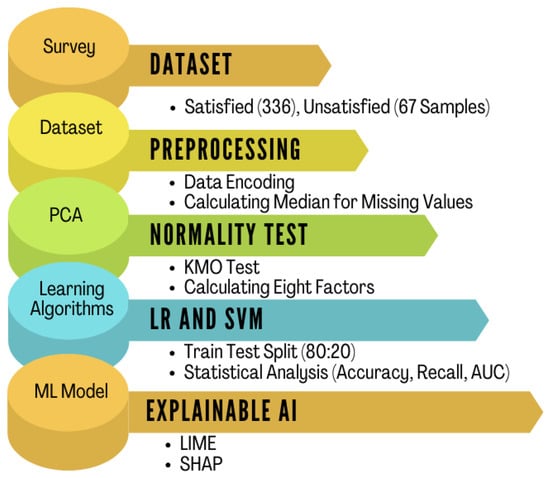
Figure 1.
Conceptual framework.
The gathered raw data were first utilized for the purpose of exploring the factors influencing customer satisfaction by using PCA to produce eight factors which explain customer satisfaction in fintech firms: customer service, ease of use, compatibility, firm innovativeness, loyalty intention, assurance, speed, and technology perception. Moreover, age, gender, education and occupation were used to see the effect of the demographic variable on customer satisfaction. Furthermore, both the variables were incorporated to machine learning models: support vector machine (SVM) and logistic regression (LR). Statistical (training accuracy, test accuracy, recall and AUC) and explainable (LIME) results were analyzed.
4. Results and Analysis
4.1. Principal Component Analysis
A MSA confirmed factor analysis, a PCA with subsequent rotation (Varimax) were conducted on 36 questions of the questionnaire concerning the customer experience and stimulus offered by F1 Soft to their customers in eight different attempts (Table 3). After those eight attempts, the resolution was found where commonalities varied from 0.523 to 0.825 where 29 items remained for further analysis. By applying Kaiser’s rule, eigenvalues greater than or equal to 1 and the scree plot (Figure 2), eight factors (Table 4) were deemed important.

Table 3.
Summary measures of different attempts. Note that MV AIC, MVC, and VE denote minimum values of antiimage correlation, minimum value of commonalities, and variance extracted, respectively.
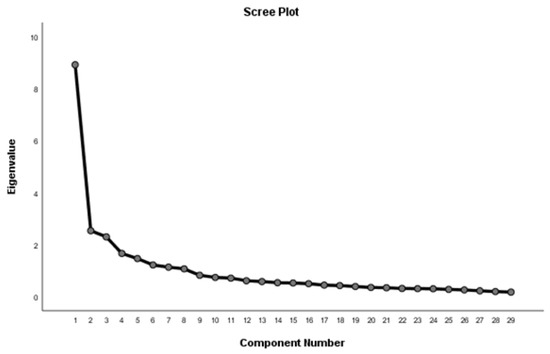
Figure 2.
Scree plot: determination of factors.

Table 4.
Eight-factor model of customer satisfaction.
Following rotation (Table 5, factor 1 was loaded five items and reflects the customer service of the organization, accounting for 11.04% of the variance exemplified by the highest loading item “Customer service agents are friendly” and lowest loading item “Customer support in resolving your issues is good”. Factor 2 was loaded with four items and accounted for 10.72% of the variance. It was highest for “Use of Esewa makes me feel good”. The third factor accounted for 8.80% of the variance with four items suggesting it was measuring ease of use. Four items included in the third factor were “Mobile payment services are easy to use”, “Requires fewer step to accomplish the transaction”, “Ease to integrate with bank accounts” and “Ease of personal details verification” where the highest loaded items were accounted for “Mobile payment services are easy to use”. Another factor which was named as assurance is the fourth factor, which constitutes four items with the highest loading on “Confidence on transaction is high and identical to the cash transaction”. This factor accounted for 8.5% of the variance. Similarly, the fifth, sixth, seventh, and eighth factors accounted for 7.93%, 7.89%, 7.48%, and 7.43%, respectively, of the variance, and each of them includes three items individually. These four factors were named as loyalty intention, firm innovation, technology perception, and speed respectively.

Table 5.
Total variance explained. Note that variance and cumulative are percentages and SSL is sum of squared loadings.
4.2. Machine Learning Approach
The proposed ML model and XAI algorithms [45] were implemented by using Keras [46] in python [47]. Experiments were executed on Google Colab [48] with NVIDIA K80 graphical processing unit of 12 GB RAM provided by Google. The runtime platform of Google Colab consists of Python (version 3.7) as a programming language, Keras (version 2.5.0), which works with the TensorFlow (version 2.5.0) framework. The entire dataset with details tabulated in Table 6 was split into the train and test sets with a ratio 90:10.

Table 6.
Summary measures of eight factors to measure customer satisfaction. CS, C, EU, A, LI, FI, TP, and S represent customer service, compatibility, ease of use, assurance, loyalty intention, firm innovation, technology perception, and speed, respectively.
4.3. Evaluation Metrics
Conventional statistical measures such as precision (Equation (2)), recall (Equation (3)), F score (Equation (4)) and accuracy (Equation (5)) were used to measure the classification performance of the model where , , , and represent true positive, true negative, false positive, and false negative, respectively.
4.4. Support Vector Machine with Radial Basis Kernel
The initial purpose of SVM is to classify binary data (satisfied or unsatisfied). For sets n of training datasets [49],
where yi is either 1 or −1, indicating the class to which xi belongs. Each xi is a p-dimensional vector. To find out the “maximum-margin hyperplane” to divide the group of xi for which yi = 1 from the group of point which yi = −1, we can write the hyperplane as
The Softmax layer lowers cross-entropy or maximizes log-likelihood, whereas SVM simply seeks to find the largest margin between data points of distinct classe of satisfaction or dissatisfaction.
The output of k-th SVM is denoted as
The predicted class is
SVM model with a radial basis kernel is applied on LIME with a training accuracy of 88.67%, test accuracy of 87.80%, recall of 100%, and AUC of 0.62%.
4.4.1. SVM Interpretation with LIME
The factor compatibility (18%), assurance (8%), speed (7%), and loyalty intention (6%) show the dissatisfaction status, whereas, as shown in Figure 3, the top three essential characteristics by SVM model to predict satisfaction are customer service (6%), technology perception (4%), and occupation (3%).
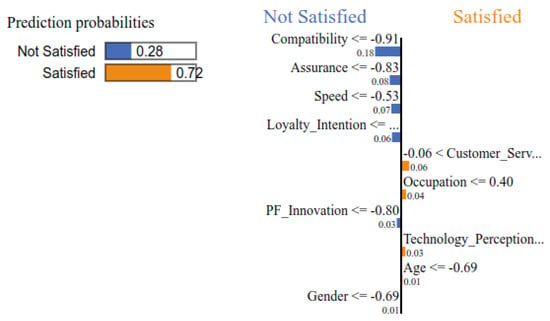
Figure 3.
SVM— Interpretation with LIME.
4.4.2. SVM Interpretation with SHAP
Absolute Shapley values for each characteristic I throughout the data were averaged to determine the overall relevance by using Equation (11):
Figure 4 shows that compatiblity, customer service, speed, loyalty intention, assurance, ease of use have the highest contribution factor.
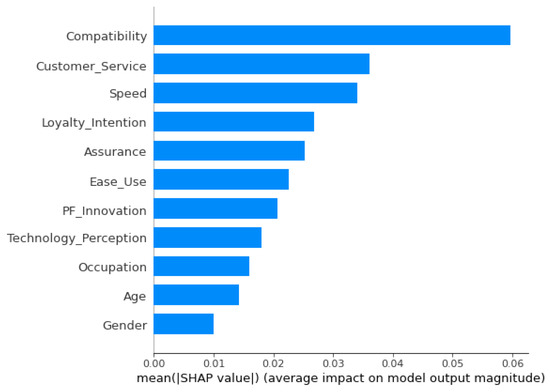
Figure 4.
SVM—Interpretation with SHAP.
4.5. Logistic Regression
For classifying the particular sample x as y (satisfied or unsatisfied), LR predicts probabilities by using likelihood, probability of y is either p if y = 1 or 1-p if y = 0, where likelihood was calculated by using Equation (12).
With 87.29% of training accuracy, 87.80% test accuracy, 94.11% recall, and 0.75 AUC, the logistic model is imposed on LIME.
4.5.1. LIME Interpretation with LR
Figure 5 interprets that compatibilty (19%), assurance (8%) and speed (8%) have the highest degree for contributing “Not Satisfied”. Interestingly, the prediction probability for the satisfaction is reduced by the features of customer service (6%), technology perception (5%), and occupation (4%).
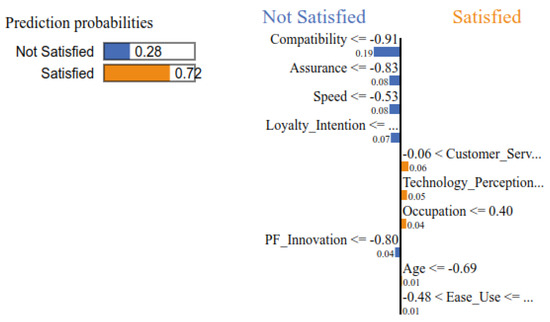
Figure 5.
LIME—Explanation with LR.
4.5.2. SHAP Interpretation with LR
Figure 6 show that compatibility, ease of use, speed, assurance, technological perception holds the major contributing factor.
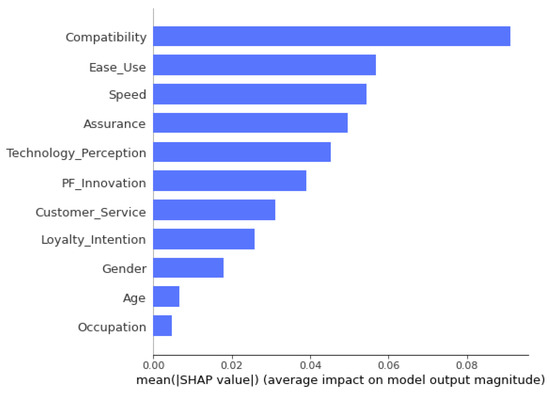
Figure 6.
SHAP—Interpretation with LR.
5. Conclusions
5.1. Discussion
The purpose of the current study was to investigate different factors for gaining customer satisfaction and implementation of machine learning. According to the study’s findings, all eight parameters were significant and regarded as reliable indicators of customer satisfaction in FinTech firms. The result of PCA indicates that the study explored the eight factors which affect customer satisfaction, which accounts for 69.79% variance extracted. Moreover, it can be seen that both SVM and LR showed the same sequence of influencing factors for the “Not Satisfied” and “Satisfied” categories where compatibility holds the highest weights for predicting dissatisfaction. The gender factor has the low weight for the same. Authors in [32] about e-banking concluded perceived value, brand perception, cost effectiveness, easy to use, convenience, problem handling, security/assurance, and responsiveness as important factors in customers satisfaction. In addition, perceived ease of use and perceived convenience had influenced the customer satisfaction toward online purchasing on Shopee in Malaysia. In the meantime, perceived usefulness and perceived trust did not significantly influence customer satisfaction toward Shopee in Malaysia [50]. Similarly, a study performed on Serbian market, seven variables categorized were security, information availability, shipping, quality, pricing, time, and customer satisfaction out of 26 different items [51]. The sustained performance of consumer satisfaction in the Chinese market primarily mediated two factors: ease and security. Usefulness, reactivity, and economy were, however, disregarded as determinants for customer satisfaction [52].
5.2. Theoretical Contributions and Practical Implications
In order to fulfill evolving client needs, financial service providers using technology should take into account that compatibility, assurance, speed, loyalty intention, and firm innovation are major factors and modify their offers as necessary. It will help raise customer satisfaction and service quality for the fintech organization.
5.3. Limitations and Future Research
As the study used judgment sampling, a nonprobability sampling technique, generalizations of the wider population, it should be used with caution. In spite of the present findings, a future scope should be provided to the researchers for conducting PCA and machine learning to explore the various factors which affect the customer satisfaction based on the reducible sampling design.
Author Contributions
Conceptualisation of the research topic and writing of the original draft were done by M.K. and M.B. Resource collection, design of methodology and code were designed by M.K. and M.B. Project administration was done by M.K., S.R.K. and M.B. Result validation was done by M.K., H.S., L.N.R., S.R.K., I.P.C. and M.B. Final draft and revisions were made by M.K. and M.B. All authors have read and agreed to the published version of the manuscript.
Funding
This research was partially funded by Kantipur College of Management and Information Technology, Tribhuvan University, Mid-Baneshwor, Kathmandu and Samriddhi College, Tribhuvan University, Lokanthali, Bhaktapur, Nepal.
Institutional Review Board Statement
Not applicable.
Informed Consent Statement
Not applicable.
Data Availability Statement
The supplementary material for this study can be found online at: https://github.com/mohanwithall/F1_Soft.
Conflicts of Interest
The authors declare no conflict of interest.
Abbreviations
The following abbreviations are used in this manuscript:
| SQ1 | How long have you been using mobile payment service of the Company? |
| TP1 | Generally, I’ve a positive view in technology. |
| TP2 | I’m a technology friendly. |
| TP3 | When using technology, I often feel overwhelmed. |
| TP4 | I don’t trust technology |
| EU1 | Mobile payment services are Easy to use. |
| EU2 | Requires fewer step to accomplish the transaction. |
| EU3 | Easy and quick recovery from mistake. |
| EU4 | Ease to integrate with bank accounts. |
| EU5 | Ease of personal details verification. |
| PV1 | Cost of using Mobile Payment services is reasonable. |
| PV2 | Feeling superiority of using services. |
| PV3 | The use of Mobile payment service is a good deal. |
| CS1 | Customer support in resolving your issues is good. |
| CS2 | Customer support team answer your inquiry promptly. |
| CS3 | Customer service agents are polite. |
| CS4 | Customer service opening hour is convenient. |
| CS5 | Customer service agents are friendly |
| A1 | Wallet payment is fully secure. |
| A2 | Confidence on transaction is high and identical to the cash transaction. |
| A3 | Statement provided by the company is thorough and accurate. |
| A4 | Mobile payment service is fully reliable. |
| PFI1 | F1 Soft is a dynamic company. |
| PFI2 | F1 Soft is a creative company. |
| PFI3 | F1 Soft is an innovative company. |
| S1 | Fund transfer time is very quick. |
| S2 | Initial log in period is much quicker. |
| S3 | Fund loading from the bank takes very low time. |
| LI1 | Use mobile payment service with us again. |
| LI2 | Recommend our payment service to others. |
| LI3 | Recommend our company to others. |
| LI4 | Favour in the future. |
| E1 | I learned a lot from using mobile payment service of the F1 Soft. |
| E2 | Makes me feel good |
| E3 | Makes me feel enthusiastic. |
| E4 | I consider myself as a member of users of F1 Soft service. |
References
- Abad-Segura, E.; González-Zamar, M.D.; López-Meneses, E.; Vázquez-Cano, E. Financial Technology: Review of Trends, Approaches and Management. Mathematics 2020, 8, 951. [Google Scholar] [CrossRef]
- Nangin, M.A.; Barus, I.R.G.; Wahyoedi, S. The Effects of Perceived Ease of Use, Security, and Promotion on Trust and Its Implications on Fintech Adoption. J. Consum. Sci. 2020, 5, 124–138. [Google Scholar] [CrossRef]
- Lim, S.H.; Kim, D.J.; Hur, Y.; Park, K. An Empirical Study of the Impacts of Perceived Security and Knowledge on Continuous Intention to Use Mobile Fintech Payment Services. Int. J. Hum.-Comput. Interact. 2019, 35, 886–898. [Google Scholar] [CrossRef]
- Suseendran, G.; Chandrasekaran, E.; Akila, D.; Sasi Kumar, A. Banking and FinTech (financial technology) embraced with IoT device. In Data Management, Analytics and Innovation; Springer: Berlin/Heidelberg, Germany, 2020; pp. 197–211. [Google Scholar]
- Weichert, M. The future of payments: How FinTech players are accelerating customer-driven innovation in financial services. J. Payments Strategy Syst. 2017, 11, 23–33. [Google Scholar]
- Yeo, V.C.S.; Goh, S.-K.; Rezaei, S. Consumer experiences, attitude and behavioral intention toward online food delivery (OFD) services. J. Retail. Consum. Serv. 2017, 35, 150–162. [Google Scholar] [CrossRef]
- Chai, L.T.; Yat, D.N.C. Online food delivery services: Making food delivery the new normal. J. Mark. Adv. Pract. 2019, 1, 62–77. [Google Scholar]
- Farah, M. Application of the theory of planned behavior to customer switching intentions in the context of bank consolidations. Int. J. Bank Mark. 2017, 35, 147–172. [Google Scholar] [CrossRef]
- Gunden, N.; Morosan, C.; DeFranco, A. Consumers’ intentions to use online food delivery systems in the USA. Int. J. Contemp. Hosp. Manag. 2020, 32, 1325–1345. [Google Scholar] [CrossRef]
- Ali, S.; Khalid, N.; Javed, H.M.U.; Islam, D.M.Z. Consumer Adoption of Online Food Delivery Ordering (OFDO) Services in Pakistan: The Impact of the COVID-19 Pandemic Situation. J. Open Innov. Technol. Mark. Complex. 2021, 7, 10. [Google Scholar] [CrossRef]
- Ajzen, I. The theory of planned behaviour. Organizational Behaviour and Human Decision Processes. Elsevier 1991, 50, 179–211. [Google Scholar]
- Bhandari, M.; Shahi, T.B.; Siku, B.; Neupane, A. Explanatory classification of CXR images into COVID-19, Pneumonia and Tuberculosis using deep learning and XAI. Comput. Biol. Med. 2022, 150, 106156. [Google Scholar] [CrossRef] [PubMed]
- Gaur, L.; Bhandari, M.; Razdan, T.; Mallik, S.; Zhao, Z. Explanation-Driven Deep Learning Model for Prediction of Brain Tumour Status Using MRI Image Data. Front. Genet. 2022, 13, 448. [Google Scholar] [CrossRef] [PubMed]
- Bhandari, M.; Parajuli, P.; Chapagain, P.; Gaur, L. Evaluating Performance of Adam Optimization by Proposing Energy Index. In Proceedings of the Recent Trends in Image Processing and Pattern Recognition; Santosh, K., Hegadi, R., Pal, U., Eds.; Springer International Publishing: Berlin/Heidelberg, Germany, 2022; pp. 156–168. [Google Scholar]
- Chapagain, P.; Timalsina, A.; Bhandari, M.; Chitrakar, R. Intrusion Detection Based on PCA with Improved K-Means. In Proceedings of the Innovations in Electrical and Electronic Engineering; Mekhilef, S., Shaw, R.N., Siano, P., Eds.; Springer: Singapore, 2022; pp. 13–27. [Google Scholar]
- Bhandari, M.; Panday, S.; Bhatta, C.P.; Panday, S.P. Image Steganography Approach Based Ant Colony Optimization with Triangular Chaotic Map. In Proceedings of the 2022 2nd International Conference on Innovative Practices in Technology and Management (ICIPTM), Pradesh, India, 23–25 February 2022; Volume 2, pp. 429–434. [Google Scholar] [CrossRef]
- Gaur, L.; Bhandari, M.; Razdan, T. Development of Image Translating Model to Counter Adversarial Attacks. In DeepFakes; CRC Press: Boca Raton, FL, USA, 2022; pp. 57–72. [Google Scholar]
- Bhandari, M.; Neupane, A.; Mallik, S.; Gaur, L.; Qin, H. Auguring Fake Face Images Using Dual Input Convolution Neural Network. J. Imaging 2023, 9, 3. [Google Scholar] [CrossRef]
- Giudici, P.; Raffinetti, E. Shapley-Lorenz eXplainable artificial intelligence. Expert Syst. Appl. 2021, 167, 114104. [Google Scholar] [CrossRef]
- Bhatta, K.R.; Durgapal, B.P. Service Quality Perceptions and Customer Satisfaction in Nepalese Banking Sector. Indian J. Commer. Manag. Stud. 2022, 7, 17–23. [Google Scholar]
- Shrestha, P. Service Quality and Customer Satisfaction: Evidence of Nepalese Banks. NCC J. 2018, 3, 121–133. [Google Scholar] [CrossRef]
- Upadhyay, J.P.; Adhikari, P.R. Corporate social responsibility and customer satisfaction in Nepal. TRANS Asian J. Mark. Manag. Res. 2022, 11, 1–10. [Google Scholar] [CrossRef]
- Shrestha, R. Customer Satisfaction with E-Banking Services of Private Commercial Banks in Nepal. Ph.D. Thesis, Department of Management, People’s Campus Paknajol, Kathmandu, Nepal, 2019. [Google Scholar]
- Kim, J.; Choi, I.; Li, Q. Customer satisfaction of recommender system: Examining accuracy and diversity in several types of recommendation approaches. Sustainability 2021, 13, 6165. [Google Scholar] [CrossRef]
- Preziosi, M.; Acampora, A.; Lucchetti, M.C.; Merli, R. Delighting Hotel Guests with Sustainability: Revamping Importance-Performance Analysis in the Light of the Three-Factor Theory of Customer Satisfaction. Sustainability 2022, 14, 3575. [Google Scholar] [CrossRef]
- Prasetyo, Y.T.; Tanto, H.; Mariyanto, M.; Hanjaya, C.; Young, M.N.; Persada, S.F.; Miraja, B.A.; Redi, A.A.N.P. Factors affecting customer satisfaction and loyalty in online food delivery service during the COVID-19 pandemic: Its relation with open innovation. J. Open Innov. Technol. Mark. Complex. 2021, 7, 76. [Google Scholar] [CrossRef]
- Ian, T.J.; Jorge, C. Principal component analysis: A review and recent developments. R. Soc. 2016, 374, 20150202. [Google Scholar]
- Trevor, H.; Robert, T.; Jerome, F. The Elements of Statistical Learning: Data Mining, Inference, and Prediction; Springer: Berlin/Heidelberg, Germany, 2009. [Google Scholar]
- Warraich, U.A.; Awais, M.; Parkash, R.; Ahmad, B. Internal marketing: An application of principal component analysis. J. Adv. Manag. Sci. 2014, 2, 55–60. [Google Scholar] [CrossRef]
- Williams, B.; Onsman, A.; Brown, T. Exploratory factor analysis: A five-step guide for novices. Australas. J. Paramed. 2010, 8, 1–13. [Google Scholar] [CrossRef]
- Olanrewaju, O.I.; Okorie, V.N. Exploring the Qualities of a Good Leader Using Principal Component Analysis. J. Eng. Proj. Prod. Manag. 2019, 9, 142–150. [Google Scholar]
- Kumbhar, V.M. Factors affecting the customer satisfaction in e-banking: Some evidences form Indian banks. Manag. Res. Pract. 2011, 3, 4. [Google Scholar]
- Xu, Z.; Zhu, G.; Metawa, N.; Zhou, Q. Machine learning based customer meta-combination brand equity analysis for marketing behavior evaluation. Inf. Process. Manag. 2022, 59, 102800. [Google Scholar] [CrossRef]
- Wei, Q.; Shi, X.; Li, Q.; Chen, G. Enhancing Customer Satisfaction Analysis with a Machine Learning Approach: From a Perspective of Matching Customer Comment and Agent Note; AIS Elibrary: Grand Wailea, HI, USA, 2020. [Google Scholar]
- F1Soft. Connecting People to Financial Services through Technology and Enabling Their Inclusion in the Formal Economy. Available online: https://f1soft.com/about/company (accessed on 17 October 2022).
- Rasool, S.F.; Wang, M.; Zhang, Y.; Samma, M. Sustainable work performance: The roles of workplace violence and occupational stress. Int. J. Environ. Res. Public Health 2020, 17, 912. [Google Scholar] [CrossRef]
- O’Connor, J. The impact of job satisfaction on the turnover intent of executive level central office administrators in Texas public school districts: A quantitative study of work related constructs. Educ. Sci. 2018, 8, 69. [Google Scholar] [CrossRef]
- Tillyer, R.; Engel, R.S.; Cherkauskas, J.C. Best practices in vehicle stop data collection and analysis. Polic. Int. J. Police Strateg. Manag. 2010, 33, 69–92. [Google Scholar] [CrossRef]
- Mitchell, W.; Wu, Z.; Bruton, G.; Gautam, D. Microlevel Analysis of Institutional Intermediation in a Rudimentary Market-Based Economy: Entrepreneurship in Kathmandu’s Indrachok Market. Organ. Sci. 2022. [Google Scholar] [CrossRef]
- Budhwar, P.S.; Sparrow, P.R. Evaluating levels of strategic integration and devolvement of human resource management in India. Int. J. Hum. Resour. Manag. 1997, 8, 476–494. [Google Scholar] [CrossRef]
- Kaiser, H.F. The varimax criterion for analytic rotation in factor analysis. Psychometrika 1958, 23, 187–200. [Google Scholar] [CrossRef]
- Kaiser, H.F. A second generation little jiffy. Psychometrika 1970, 35, 401–415. [Google Scholar] [CrossRef]
- Kaiser, H.F. An index of factorial simplicity. Psychometrika 1974, 39, 31–36. [Google Scholar] [CrossRef]
- Bartlett, M.S. A note on the multiplying factors for various χ 2 approximations. J. R. Stat. Soc. Ser. 1954, 296–298. [Google Scholar] [CrossRef]
- Loveleen, G.; Mohan, B.; Shikhar, B.S.; Nz, J.; Shorfuzzaman, M.; Masud, M. Explanation-Driven HCI Model to Examine the Mini-Mental State for Alzheimer’s Disease. ACM Trans. Multimedia Comput. Commun. Appl. 2022. [Google Scholar] [CrossRef]
- Chollet, F. Keras. 2015. Available online: https://github.com/fchollet/keras (accessed on 17 October 2022).
- Van Rossum, G.; Drake, F.L. Python 3 Reference Manual; CreateSpace: Scotts Valley, CA, USA, 2009. [Google Scholar]
- Carneiro, T.; Medeiros Da NóBrega, R.V.; Nepomuceno, T.; Bian, G.B.; De Albuquerque, V.H.C.; Filho, P.P.R. Performance Analysis of Google Colaboratory as a Tool for Accelerating Deep Learning Applications. IEEE Access 2018, 6, 61677–61685. [Google Scholar] [CrossRef]
- Tang, Y. Deep learning using linear support vector machines. arXiv 2013, arXiv:1306.0239. [Google Scholar]
- Yo, P.W.; Kee, D.M.H.; Yu, J.W.; Hu, M.K.; Jong, Y.C.; Ahmed, Z.; Gwee, S.L.; Gawade, O.; Nair, R.K. The influencing factors of customer satisfaction: A case study of Shopee in Malaysia. Stud. Appl. Econ. 2021, 39. [Google Scholar] [CrossRef]
- Vasić, N.; Kilibarda, M.; Kaurin, T. The influence of online shopping determinants on customer satisfaction in the Serbian market. J. Theor. Appl. Electron. Commer. Res. 2019, 14, 70–89. [Google Scholar] [CrossRef]
- Choi, Y.; Sun, L. Reuse intention of third-party online payments: A focus on the sustainable factors of Alipay. Sustainability 2016, 8, 147. [Google Scholar] [CrossRef]
Disclaimer/Publisher’s Note: The statements, opinions and data contained in all publications are solely those of the individual author(s) and contributor(s) and not of MDPI and/or the editor(s). MDPI and/or the editor(s) disclaim responsibility for any injury to people or property resulting from any ideas, methods, instructions or products referred to in the content. |
© 2023 by the authors. Licensee MDPI, Basel, Switzerland. This article is an open access article distributed under the terms and conditions of the Creative Commons Attribution (CC BY) license (https://creativecommons.org/licenses/by/4.0/).